Who doesn’t love the brilliant colors of Mexico? Whether it’s the stunning aqua of the ocean or a brilliant magenta plant, these bright tropical colors will help any visitor from the northland shed their winter blahs. So, it’s not surprising that visitors to Mexico want to bring some of that vibrant color home with them. One of the best ways to bring travel home is to pick up a piece or two of colorful Mexican pottery. But all Mexican pottery is not the same and I was surprised to find that “traditional” Mexican pottery did not all originate in Mexico.
Here are my suggestions on how to collect Mexican pottery.

The brilliant colors of Mexico will inspire you and lift your spirits. Photo by Elizabeth R Rose
The Origin of Mexican Pottery
Some of the most interesting yet simple clay pottery has a history that is rooted in the culture of the indigenous people of Mexico. As with the Native American pottery of the United States, the original pre-Columbian pottery was strictly utilitarian. The early Olmec people fashioned clay vessels for everyday use but also created fanciful animal and human shapes, some of them for ceremonial use. If there was any design at all, it was made using natural pigments.
The Olmecs (1500 BC – 800 AD) then passed their pottery-making traditions to the cultures that came after them like the Aztecs and Maya. You can still find hand-made simple clay pottery for sale in rural areas and, of course, the oldest pieces will be displayed in museums.
Subsequent Mexican pottery traditions, those associated with the highly collectible colorful Mexican pottery of today, were brought from countries like Spain and Italy. Even these European ceramic traditions were influenced by the Arabic and Chinese cultures. When the Spaniards arrived, the indigenous people learned the new techniques from them. Colorful pieces like the Talavera pottery of today are the result.
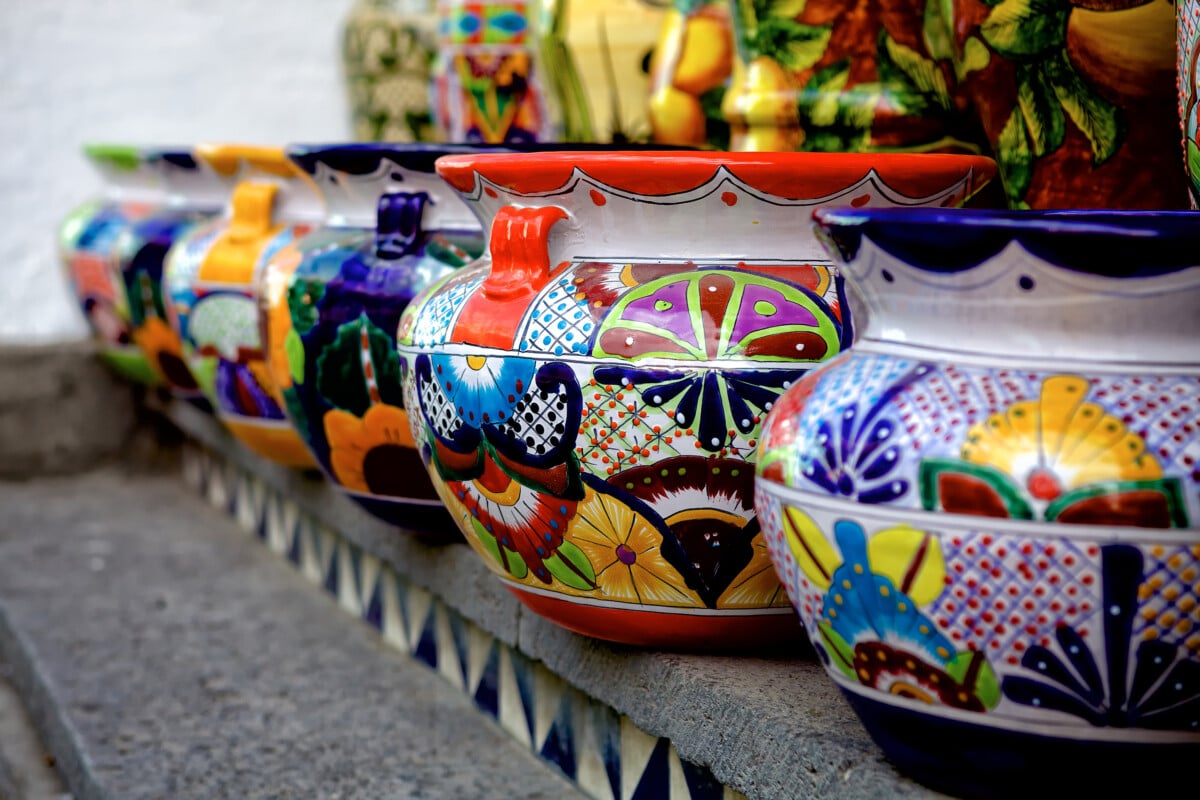
Talavera style pottery in Puebla, Mexico. Photo by marcviln via iStock by Getty Images
In the 1950s, shiny ceramics and stoneware fired at high temperatures were introduced to Mexico by both Mexican potters who studied in Japan and China and pottery artists from Europe and the United States who founded workshops in Mexico. This type of pottery is often suitable for dinnerware and differs from region to region, but what defines it is the high heat used for firing.
Several types of Mexican pottery have found their way to my home, brightening each room and my patio and bringing back fond memories of my visits to the land south of the border.
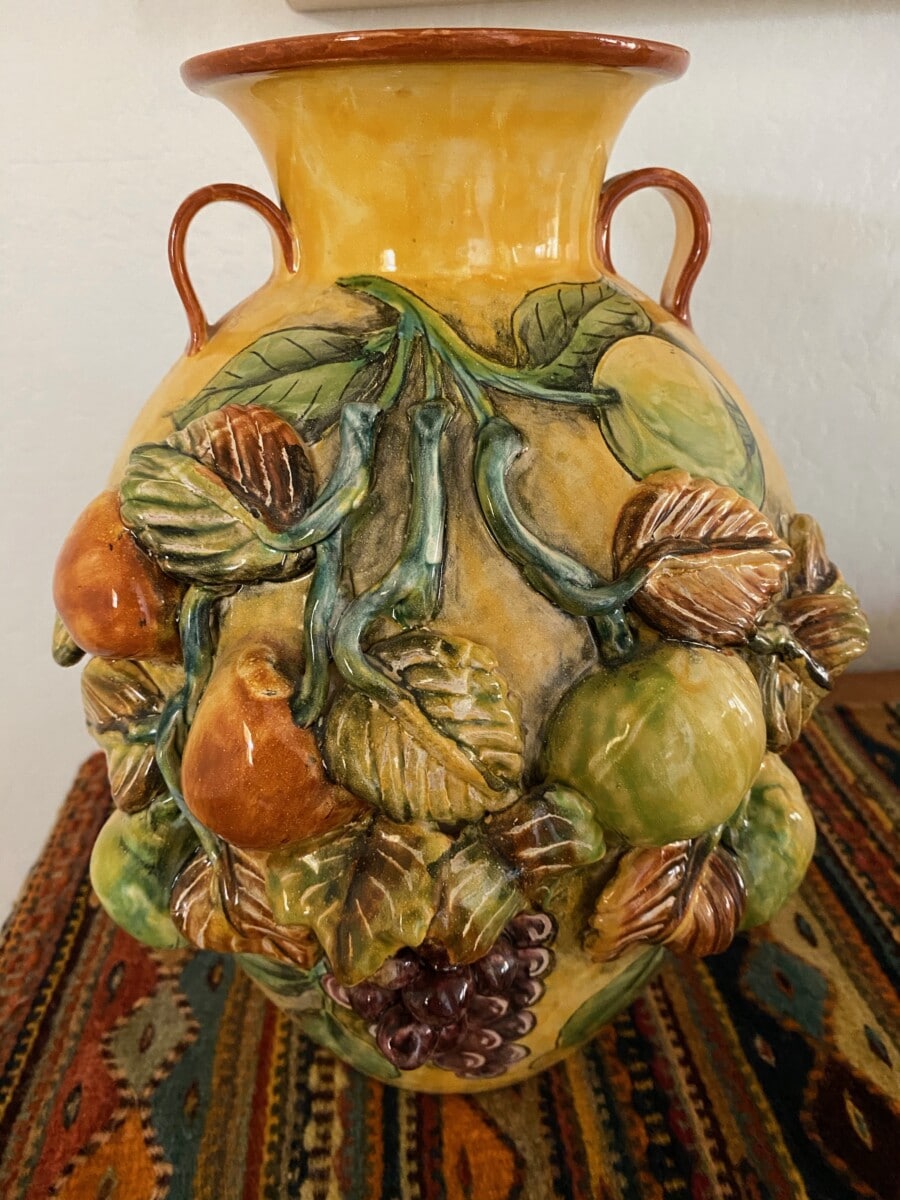
This Mexican pottery vase with raised fruit has a place of honor in my entryway. Photo by Elizabeth R Rose
Shopping for Mexican Pottery
You can have some fun bargaining for little pottery animals, salt and pepper shakers, and souvenir plates at the markets in most Mexican towns. Or, if you are a serious collector save your money for a visit to a reputable gallery or go to the factory where the pottery is made.
Touring a Factory
My first experience with Mexican pottery was on a day trip to Tlaquepaque, a suburb of Guadalajara. We had a lunch of enchiladas, beans, and fresh fruit salad in a plant-filled courtyard, were just ready to order another Margarita, and our group leader said we’d be going to El Palomar, an authentic pottery workshop.
Little did I know that Ceramica El Palomar was well-known internationally. The workshop was founded in Tlaquepaque in 1964 by famed ceramist Ken Edwards and other artists who had studied abroad. The place we were to visit was the original producer of quality high-fired stoneware used in dinnerware and highly collectible art pieces. We were told that El Palomar is a family-run workshop where every piece is inspected and overseen by the owners. While the work is marked El Palomar, you’ll always see the mark of the proud artisan, often an animal or insect symbol.
As I watched the artisans at work at simple wooden tables and toured the room with the high-temperature kilns, I began to think about what type of Palomar pottery I wanted to take home.
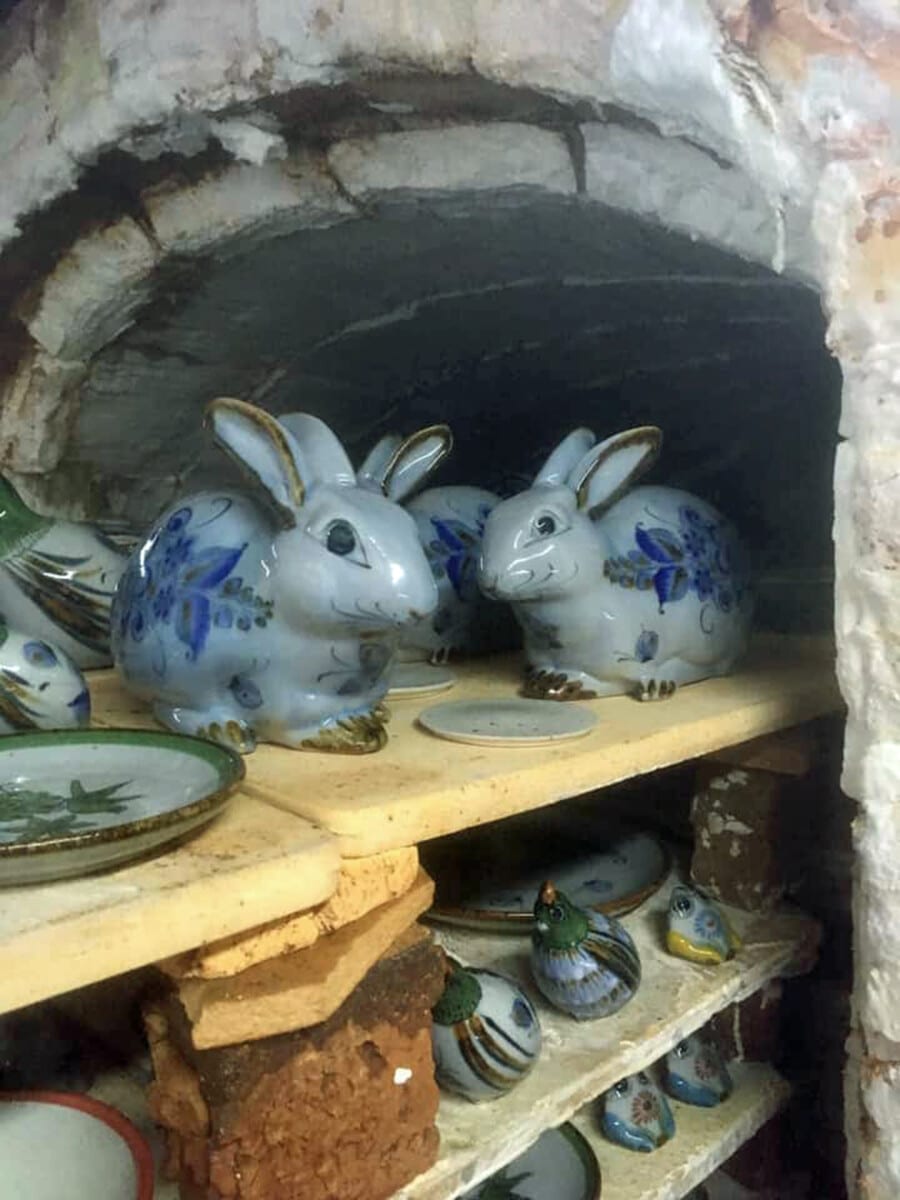
Just out of the kiln at El Palomar. Photo by Elizabeth R Rose
We visited both the retail store and the area where there were seconds, much more affordable for me. I fell in love with a skillfully made armadillo and a sweet rabbit embellished with flowers. To this day, I have never been able to find the “defects” that banished these two animals to the seconds table!
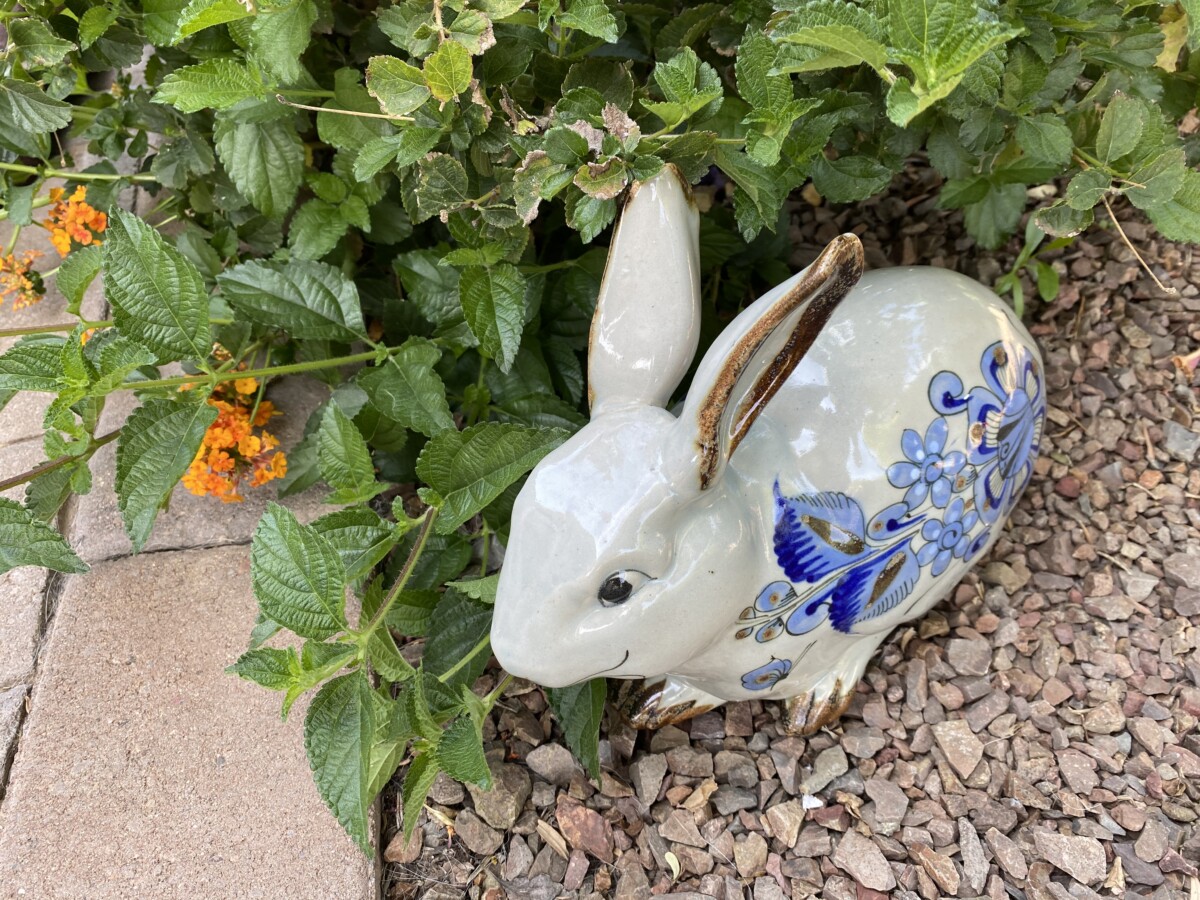
This El Palomar Rabbit appears each Easter at my home. Photo by Elizabeth R Rose
Finding Mexican Pottery Shops
If you want to be guaranteed a piece of pottery that is authentic or dinnerware that is truly lead-free, it is best to go directly to the shop associated with the factory. If you cannot do that, consider a reputable dealer that carries the line of pottery that you are interested in. The salespeople should be able to answer detailed questions about the pottery and how it was made. Often a hotel concierge can suggest a well-respected shop, or, you can do some Internet research ahead of your trip.
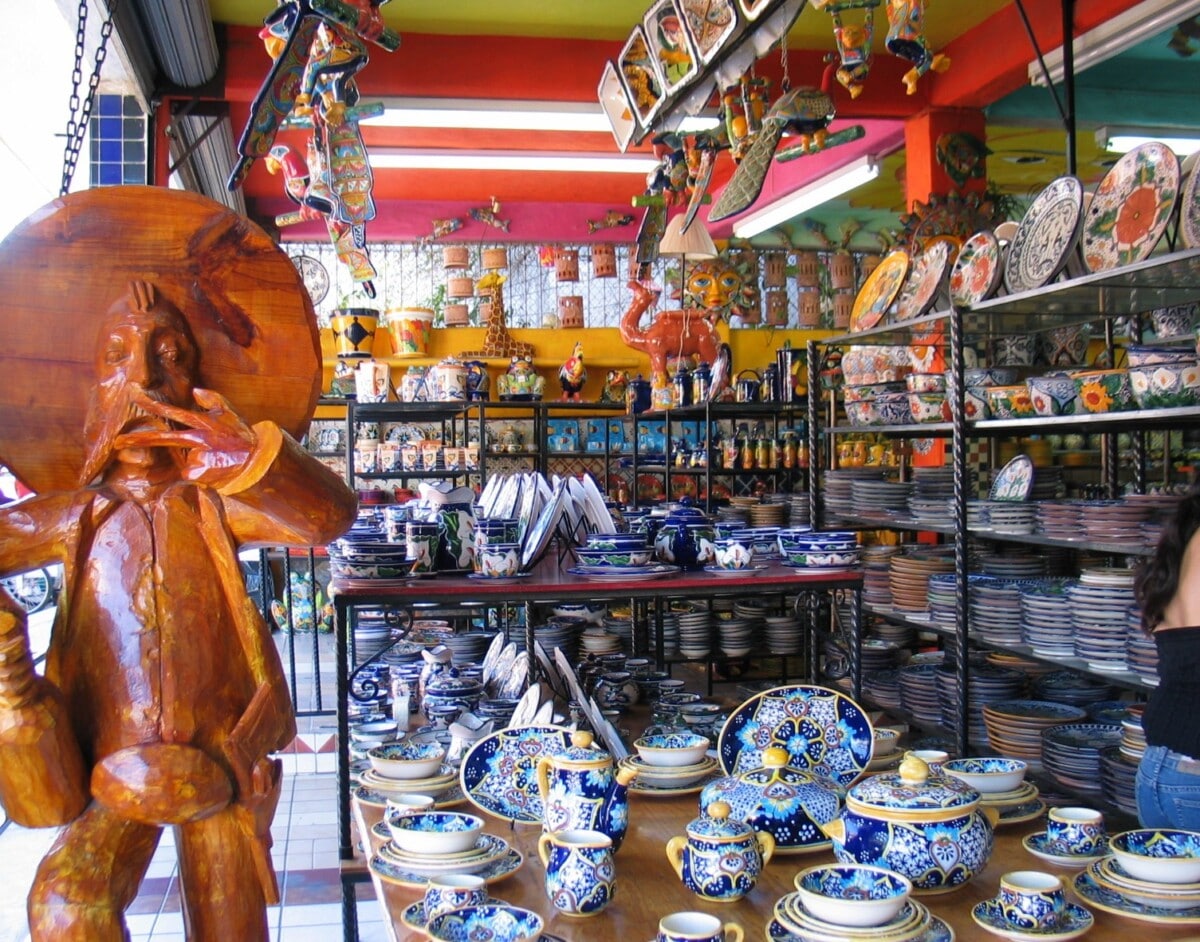
This shop in Puerta Vallarta was known for an excellent selection of dinnerware. Although not authentic Talavera, these designs were inspired by the Talavera pottery of Puebla and were guaranteed to be lead-free. Photo by Elizabeth R Rose
When vacationing in Mexico, I found that most tourist shops with handicrafts offered some of the regional pottery as well. These are often colorful, fun-to-have pieces that you’ll treasure as a remembrance of your trip. I would recommend skipping this type of shop if you want to use the pottery at home for food, though. You just never know.
Galleries for Mexican Pottery
Artisan cooperatives and galleries are ideal places to find Mexican pottery. It was a gallery that introduced me to fanciful folk art clay pottery which is painted rather than glazed. You may see the elaborate Arboles de Vida (trees of life), often with a Biblical theme, for sale in galleries. These trees have many intricate pieces, all attached to the trunk and branches by wires.
One clay figure that really caught my attention was in a gallery in Cabo San Lucas. A painted skull with flowers and Monarch butterflies, often associated with the Day of the Dead, was on display along with hand-blown glass sculptures, Talavera-inspired pottery, and other seductive souvenirs of Mexico. After looking at the price, I forced myself to keep walking and check out an artisan’s market on the wharf. But a true collector would have considered that little gallery a find.
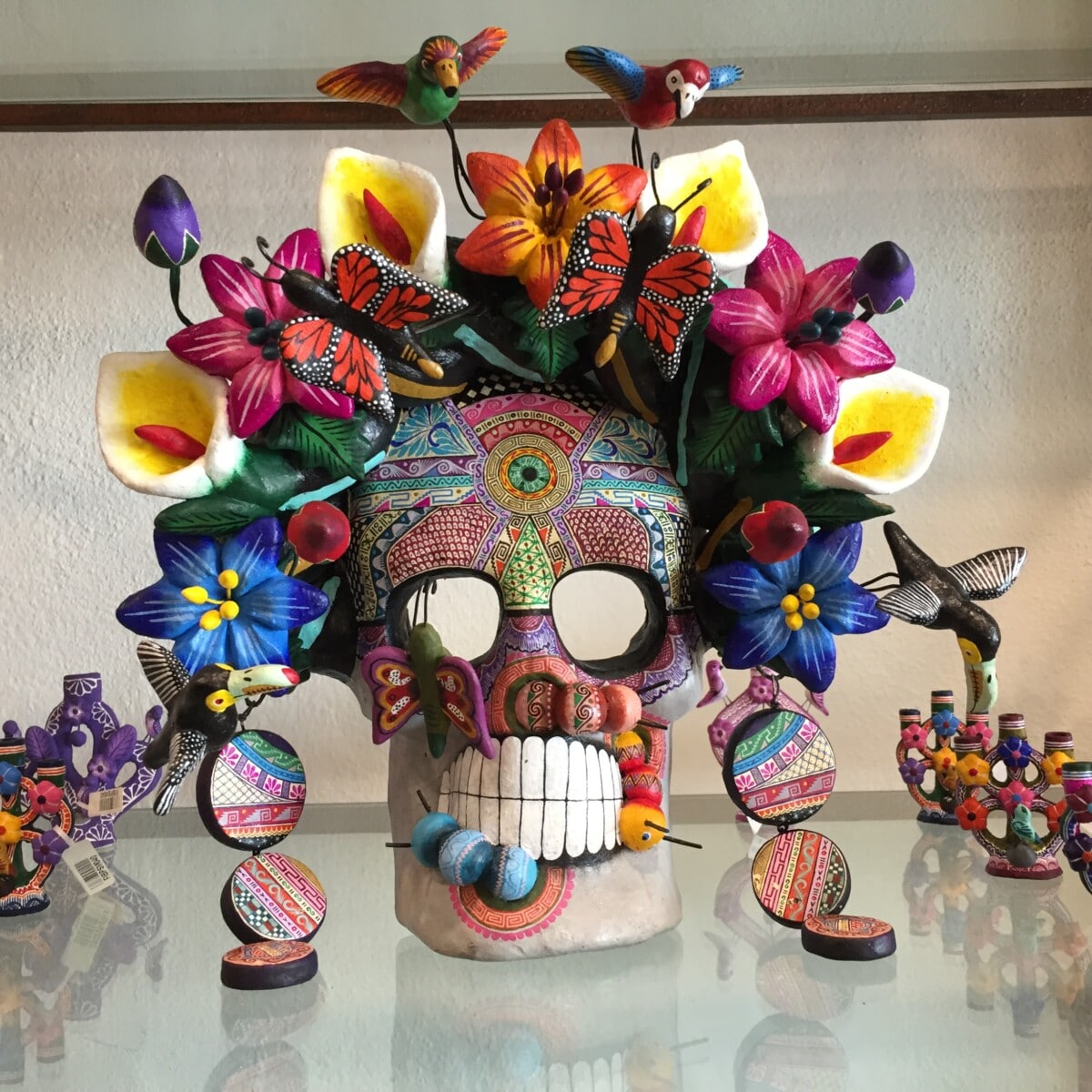
This fanciful clay skull was on display at a Cabo San Lucas gallery. Photo by Elizabeth R Rose
Mexican Pottery for Your Garden and Home in the U.S.
When you tour the southwestern United States, you’ll find places to buy colorful Mexican pottery, some suitable for inside use and some for outdoor container gardening. In Tubac, Arizona, for example, head for La Paloma de Tubac. In an old adobe, you’ll find a carefully chosen collection of Mexican and Latin American items for your home and to wear. And, surrounding the building, is a colorful array of planters and statues for your garden. It’s at La Paloma that I fell in love with Talavera-style pottery.
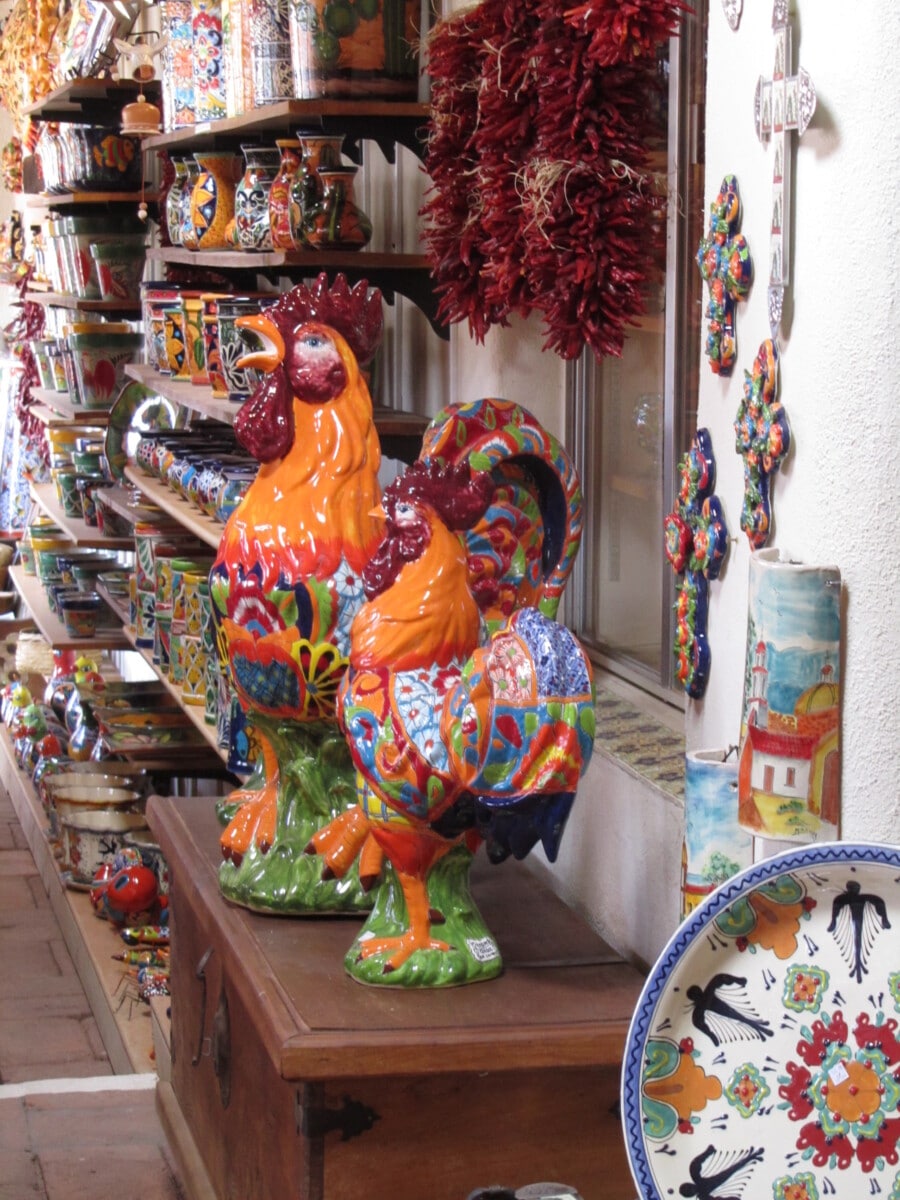
Pottery roosters were featured at La Paloma in Tubac. Photo by Elizabeth R Rose
The Talavera style of pottery was introduced to Mexico in the Colonial period by Spanish artisans from the Spanish pottery-making center, Talavera de la Reina. Traditional Talavera, a type of majolica, or tin-glazed earthenware, is decorated blue on white but Mexican artisans have introduced more colorful patterns depicting animals, insects, and flowers. True Mexican Talavera pottery is from the Puebla area and is certified by Consejo Regulador de la Talavera, a Mexican governmental entity. However, in reality, almost any type of colorful Mexican pottery (usually color on a white glaze background) is informally called Talavera. At La Paloma, I purchased decorative pottery for my kitchen to give it a colorful south-of-the-border look.
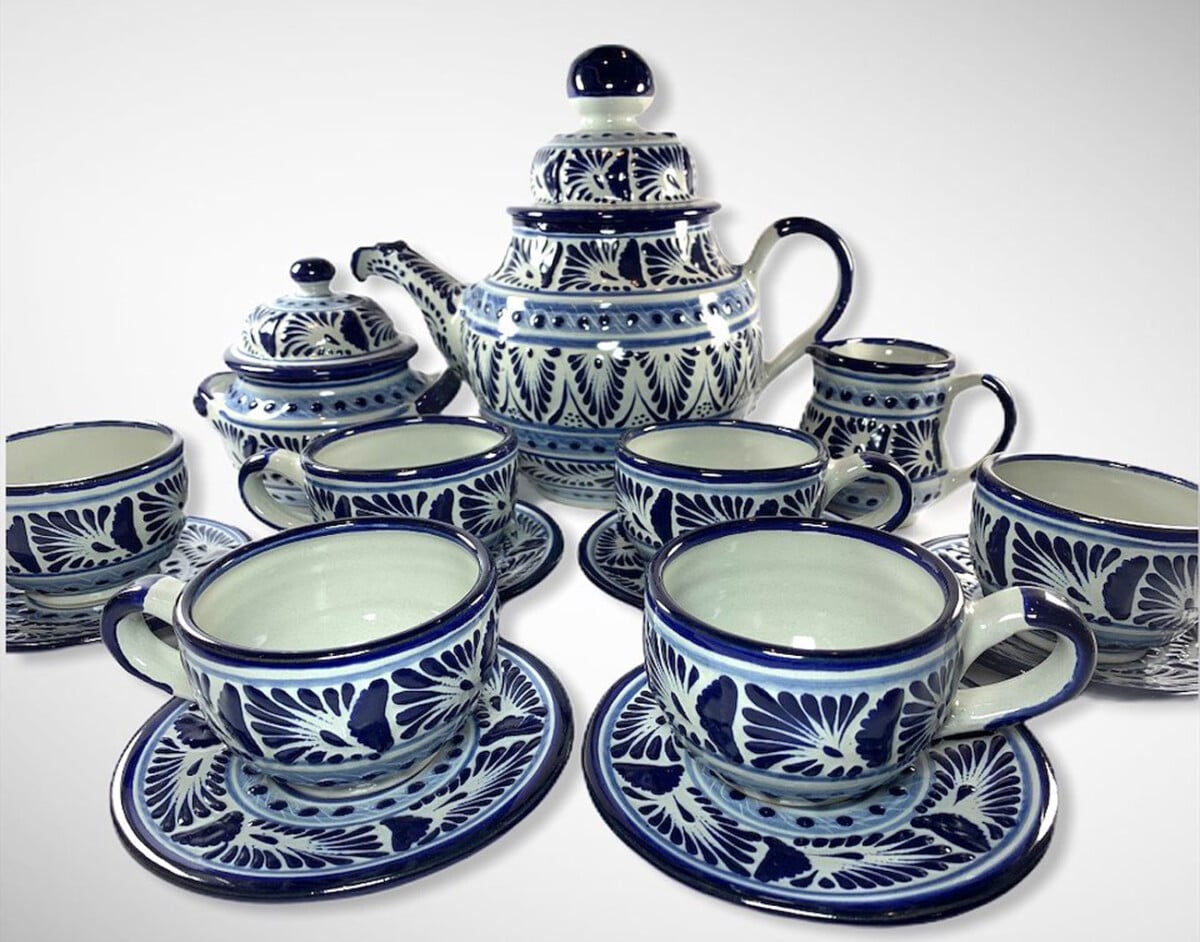
This is the more traditional Talavera color and design. Photo courtesy Talavera Salazar, Puebla.
In the Phoenix area, people love outdoor living and often decorate their patios with colorful plants and cacti arranged in Mexican pottery containers. A fun place to look for Mexican pottery often labeled Talavera is on Highway 60 just north of Surprise, Arizona. The pottery shops there carry all sorts of garden kitsch and décor but the star is rows and rows of colorful Mexican pottery trucked up regularly from Mexico.
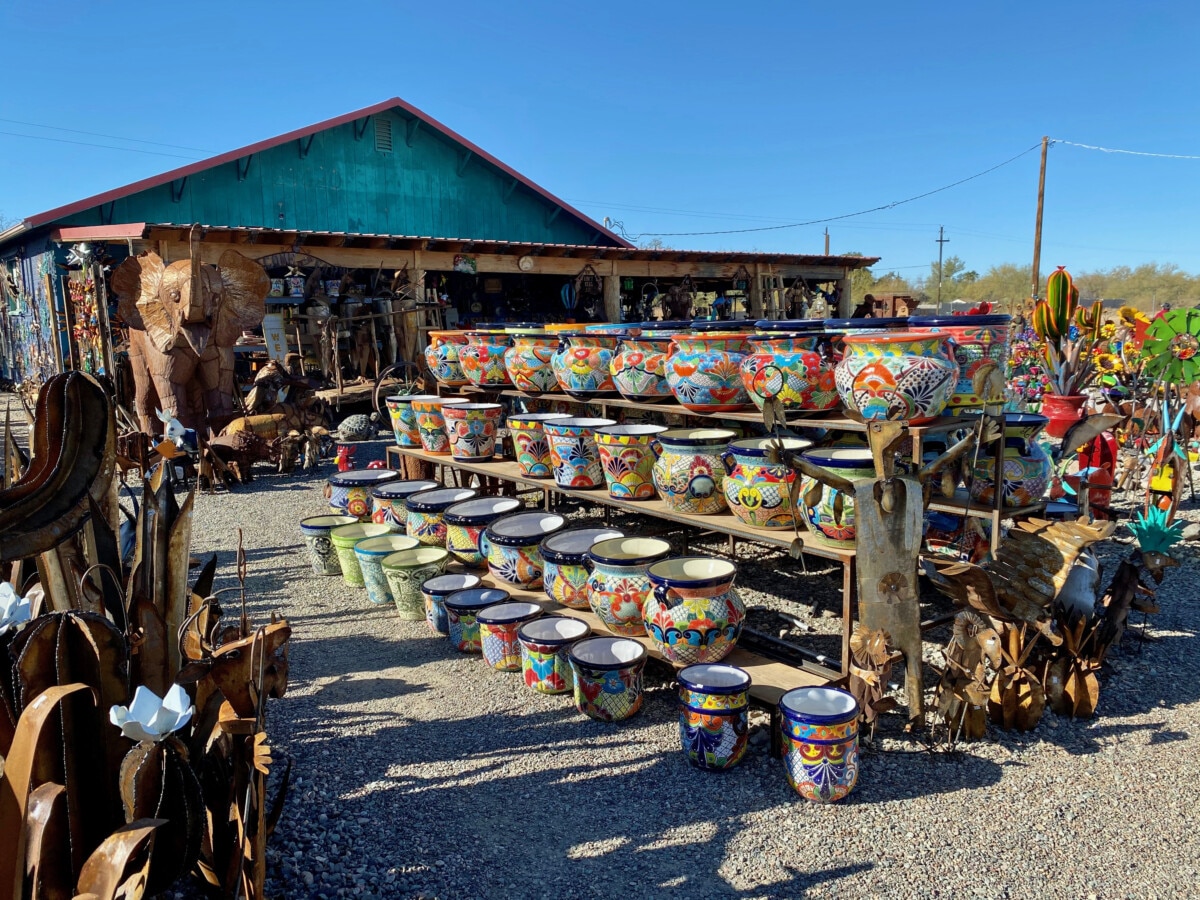
The Mexican pottery shops just north of Surprise, Arizona, are a great place to shop for garden art. Photo by Elizabeth R Rose
You’ll find pottery lizards and other animals for your garden wall, pots to hang, huge pots that hold a tree next to your pool, and little pots for your succulent collection. There’s no guarantee that the pottery will hold up forever in the Arizona sun and may get craze marks in time, but the price is right and there are several shops to choose from in that one area.
Buying Mexican Pottery Online
Some of the pottery makers who have caught my eye on Instagram include Gorky Pottery, the Guanajuato workshop of artist Gorky Gonzalez, who is an award-winning majolica master and has integrated aspects of Japanese pottery making into his work.
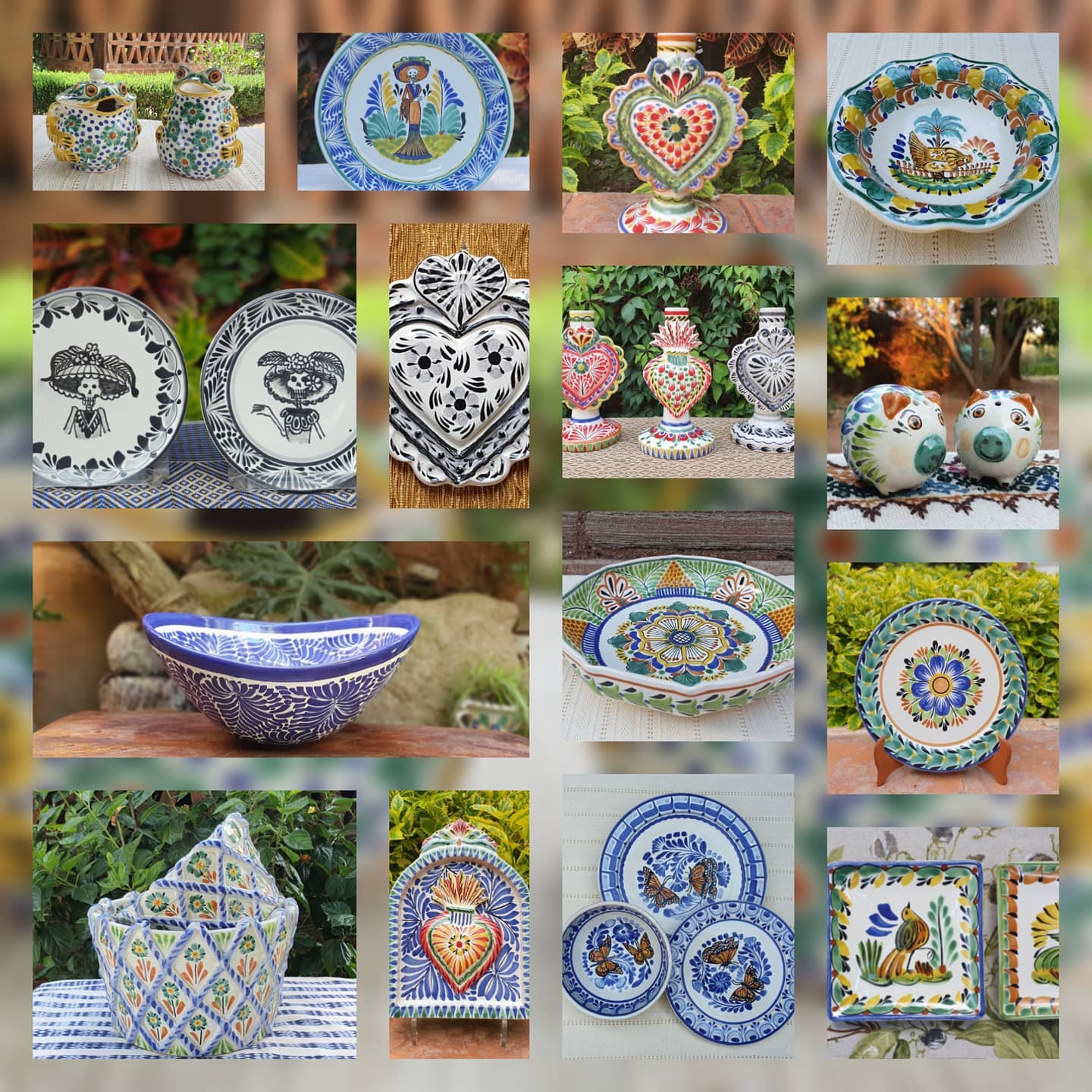
At Gorky Pottery of Guanajuato, you’ll find everything from ceramic Christmas decorations to highly collectible dinnerware. Photo courtesy Gorky Pottery Facebook.
Etsy has shops featuring Mexican pottery. Now that you know what to look for, you can shop with more confidence. Wander suggests these Etsy retailers:
The Encantada Shop
The Encantada Shop is a place you will find Mexican pottery, hand-carved decor for your home, woven items such as market baskets, and more.
Mexicanhobo
Mexicanhobo features both Mexican and Latin American decor items for your home as well as embroidered clothing to wear. You’ll find colorful Mexican pottery as well as Mexican blown glass.
Mexican Talavera
The Mexican Talavera shop offers hand-painted and handmade Mexican pottery. How about Mexican tile house numbers and switch plates for your home or some unique pots and vases?
QuetzalArtsMX
Quetzal Arts offers colorful Mexican pottery mugs, pots, and vases as well as a great line of Day of the Dad skulls.
Gorky Gonzalez Pottery
My favorite pottery company, Gorky Gonzalez, offers many design lines, including the Monarch butterfly design that is winging its way to my home in the form of a platter!
Once you are knowledgeable about a particular pottery tradition, you might be adventurous and check out offerings on eBay. Or, for the more cautious, some of the major pottery makers have websites where you can purchase anything from a trinket dish to a full set of dinnerware.
Before You Shop
Read up on the pottery traditions of the area where you will be visiting. Some books that will give you a start are:
If you have a strong interest in Mexican pottery or folk arts consider taking a guided tour focusing on the arts and crafts of Mexico or while you visiting a city, ask about a day tour to Mexican pottery workshops and stores. For more inspiration on how to bring travel home with you, see these articles by Wander writers who love travel and have researched products, foods, and art from destinations around the world that can enhance your home and lifestyle.





Hi! Thanks for your interesting article! I too am a lover of the brightly colored mexican pottery! I bought a butter container, (oval dish with a raised cover) that said “Lead Free” but now you have me thinking. How can I know if it is really just that? Do you know if there is something I can coat the bottom with where the butter sits in case there is lead in it?
To me, it all depends on where you purchase it. Usually, the items are marked “Lead-Free” on the bottom. And if you purchase the item from a reputable dealer (vs. a cute little village market or antique shop), you should be fine. This article may be of interest: https://www.fda.gov/food/metals-and-your-food/questions-and-answers-lead-glazed-traditional-pottery Liz